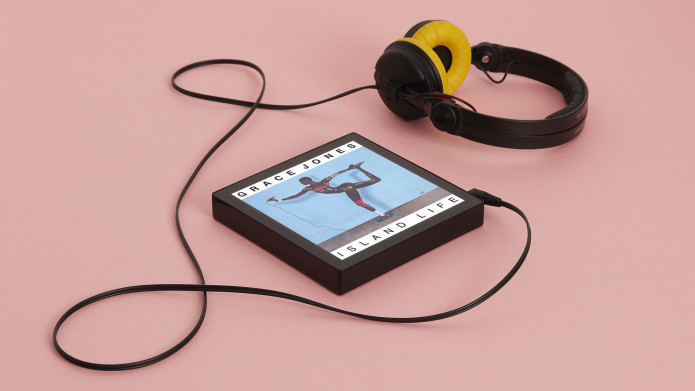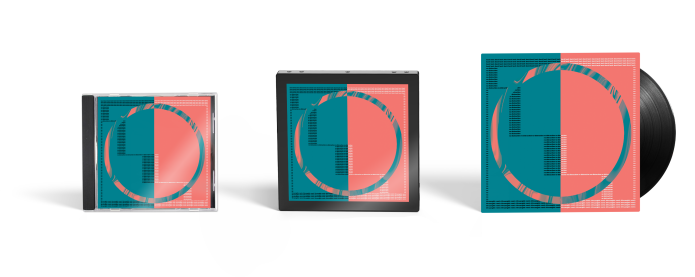
About device
I have been waiting for a large player from the market for a long time, which is able to fully display the classic CD cover. At the same time, I wanted it to be precisely a device specifically designed for multimedia playback and integration into services such as Spotify. And when I came across the mention of the Sleevenote player from Tom of the Century, I realized that this is exactly what I expected from the market. From a technical point of view, this is a combination of a DAC player, a streamer and a headphone amplifier in one device. The device is portable and quite massive, due to the need for a high-capacity battery.
Thus, at the start we have a project of a square device, with a silhouette somewhat reminiscent of the good old blackberry passport. The player's screen with a size of 7.5 inches allows you to view graphic files with album cover, tracklist, lyrics, etc. Inside the "beast" we will find a Cirrus HQ DAC, a Wolfson class W amplifier, and a base memory of 256 GB.

Essentially a class W amplifier is the commercial name for a class H amplifier ... In other words, the actual class B (according to the traditional classification) with floating voltage supply rails. At low levels of output voltage, the device is powered from the low voltage busbars of the line source. An increase in the output voltage, for example, when connecting high-impedance headphones, the built-in tracking pulse converter increases the voltage on one of the buses.
As conceived by the creators, the battery of the device, with all these delights, should be enough for at least 12 hours of continuous battery life when using wired headphones and an Internet connection. Accordingly, the capacity of the Sleevenote must be at least 5000 mAh. It is supposed to use Wi-Fi and Bluetooth to download files, the latter can also be used to connect to headphones or smart speakers. The analog headphone jack is standard 3.5 mm.
The use of the Wolfson amplifier indicates the possibility of connecting high-impedance (300 or more Ohm) headphones to the player, due to the high voltage that this amplifier is capable of creating at the output. Cirrus HQ supports 24 bit / 96 Hz, so the device can be called a Hi-Res player without exaggeration. The developers also promise support for Apple Music and Spotify and some kind of their own collection of 1,000 albums, and are also planning to negotiate with streaming services.
Why it might not be
In this cycle, I allow myself to be biased. I literally fell in love with the concept, renders, characteristics and thought that even if I don’t donate now, I’ll probably buy it later. Even though the $ 707 purchase is a very impressive blow to my pocket and the fact that it seems to be not rational. Personally, when I look at this thing, I have the idea that with the help of this thing I want to listen to music. But, most likely, I will not have to do this.
Not everyone shares my enthusiasm. Most use wireless headphones today. Even though the device has the ability to connect them, it remains unclear why overpay for a DAC and built-in amplifier. The form factor can hardly be called pocket-sized, if you recall CDs, they were placed in a rare pocket, and, as a rule, they carried a special bag with files for them. The Sleevenote is also thick enough to almost certainly won't fit in most pockets.

Comparison of box sizes from CD, player and vinyl disc
Ie. you will need an additional accessory in order to use it as a more or less portable wearable gadget. And naturally, the cost approaching some flagship smartphones is also a strong demotivating factor.
I quickly polled a small group of my friends on social media. networks to determine if they would buy such a device if they had enough money. The majority (about half) answered that they did not see the point in players as separate gadgets, about a third considered such a purchase unreasonable and admitted the possibility of buying only if they had all the gadgets that they had planned to buy before. Several suggested that this is some kind of gadget from the past and only one person, like me, said that this is a very cool thing that should be purchased if possible. Almost everyone agreed that it was too much money for a device for listening to music. Many have noted the impracticality and low functionality of the player.
It is clear that the data of such a survey is not representative, but it reflects the typical view of a relatively small user on devices of this kind. Namely, young people under 40 are the main users of crowdfunding platforms.
Dry residue
The device is specific, and if the potential of the idea is viable in the market, then most likely in a very narrow niche segment. Subjectively, I can evaluate Sleevenote as exactly what I will gladly replace my laptop and phone with when listening to music. Unfortunately, there are relatively few objective reasons to believe that the project will raise the required $ 660,000. In the comments I will be grateful for your opinion on the concept and its future, I also invite you to participate in the survey. Learn more about the device here.
Advertising
in our catalog a wide range of diverse electronics: headphones, amplifiers, speakers, televisions, and other devices.